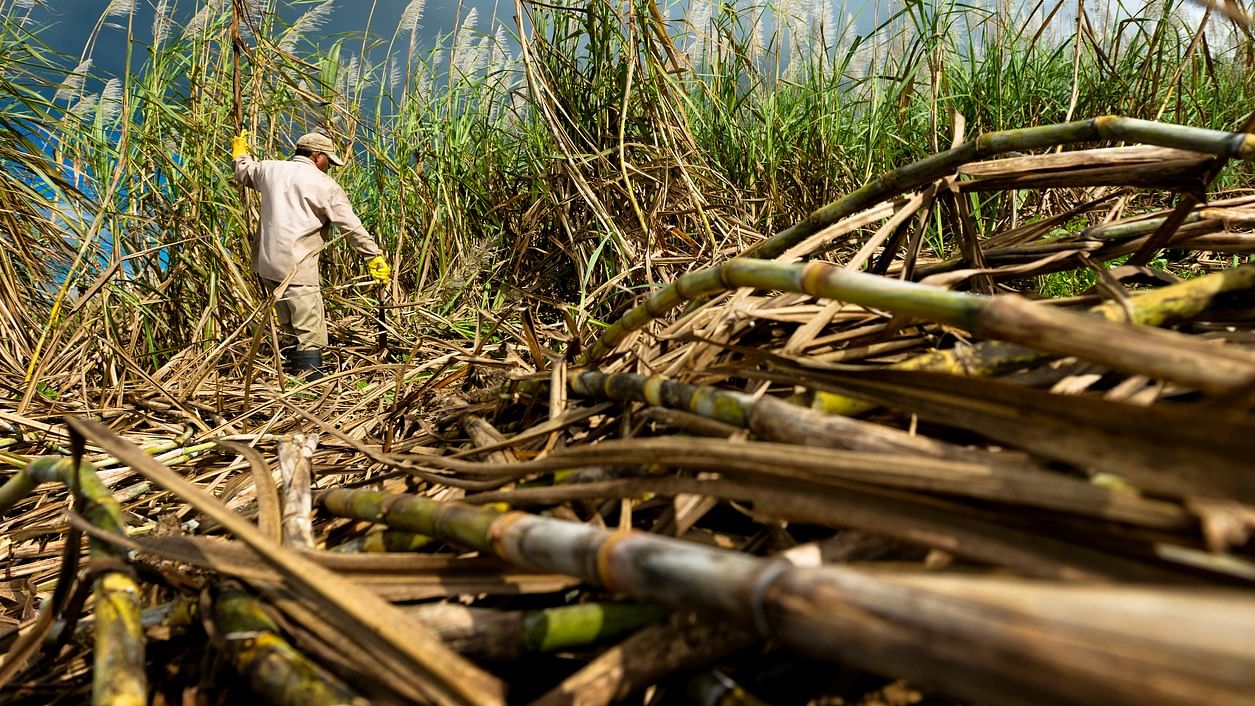
Representative image showing a farmer harvesting sugarcane in India.
Credit: iStock Photo
Ethanol has been seen as an important renewable fuel worldwide for more than 40 years. Ethanol is mainly made from the fermentation of biomass such as sugarcane, sugar beet, and corn, and vehicles that use this as fuel produce net lesser emissions than conventional gasoline-run vehicles. This also helps in reducing the oil import bill and attaining a certain level of energy independence.
In India, ethanol is mainly produced from sugarcane molasses. In 2003, India took a pioneering step in introducing ethanol as an automotive fuel. However, there were a lot of challenges that hampered the adoption of ethanol, such as the requirement of high investments to set up distillation capacities to process ethanol, the non-inclusion of grains in the ethanol policy, and the limited availability of feedstock.
Three routes
The intention of bringing in the National Policy on Biofuels was to mainly address the issue of the mounting import bill of India. In FY2023, India had to import crude oil worth $162.2 billion. With a policy to blend ethanol in fuel, a significant percentage of crude imports will be substituted with domestically produced ethanol. As per the target set by the government, 20 per cent ethanol blending is to be achieved by 2025 (Revised from 2030) with 10 per cent blending already achieved.
There are primarily three routes to produce ethanol from sugarcane – the C-heavy route is the processing of ethanol from molasses that can no longer be used for sugar crystallisation. This was the only route allowed for ethanol production before the policy was enacted. The idea behind this rule was to negate any possibility of a shortfall in sugar production, which could have sent the price of the commodity upwards.
To boost the supply of ethanol, the policy legalised the production of ethanol from B-heavy and cane juice mode. This meant that sugar mills now had the option to produce ethanol directly from crushed sugarcane instead of producing sugar which is known to be a cyclical commodity. In addition, the policy expanded the scope of raw materials to be used for ethanol production by allowing the use of other sugar-containing materials like sugar beet, starch-containing materials like cassava, damaged food grains like broken rice, and rotten potatoes, unfit for human consumption.
Progress made so far
To achieve the milestone of 20 per cent ethanol blending in fuel by 2025, India’s ethanol demand would be nearly 1,100 crore litres. As per the current ESY (Ethanol Supply Year), the total supply of ethanol was 413 crores litres till August 2023. This means the supply will need to be more than doubled in the next three years to achieve the blending target of the government.
The machinery required to produce ethanol for a sugar- or a grain-based plant is in the form of a distillery which requires significant investment. Almost every sugar company has made investments or is undergoing capex into sugar-based or grain-based distilleries at this point. Currently, the total distillery capacity in India is around 950 crore litres, which includes 620 crore litres of molasses-based distilleries and 330 crore litres of grain-based distilleries. Most of the larger sugar companies are likely to complete their distillery capex by January 2024.
Risks ahead
The optionality to produce ethanol from sugarcane juice and B-heavy molasses has indeed made the prospects for sugar mills better than what they were before the National Policy on Biofuels came into the picture. By diverting a certain portion of crushed sugarcane towards ethanol, there is a lower possibility of over-production of sugar which would result in the collapse of sugar prices earlier, which would in turn hamper the margins of sugar mills. However, certain risks and concerns remain in the sector. If the government increases the minimum price to be paid to sugarcane farmers, the margins of sugar mills would be directly impacted. The sugarcane crop requires a large amount of water and, hence, is dependent on rainfall. Any rainfall deficit or adverse weather conditions could also have a negative impact on the value chain of sugar companies.
To negate the issue of dependency on sugarcane prices, a lot of sugar mills are setting up grain-based distilleries for ethanol production. The feedstock in these would be broken rice, maize, or other damaged grains. This would provide a sugar mill that has an attached grain-based distillery flexibility in terms of feedstock usage.
As far as the consumers are concerned, ethanol-blended petrol impacts fuel efficiency by 6-7 per cent. This is mainly because ethanol has a lower calorific value than petrol. There are some concerns that 20 per cent ethanol blending could result in faster corrosion of certain engine components and would require replacement during the vehicle lifecycle.
However, the focus of government currently seems to be on the benefits of blending in the form of energy self-reliance, reducing import costs, and reducing carbon emissions. It will be important for the stocks of companies in this sector that the government does not deviate from its blending target, and has a roadmap in place regarding ethanol once the 20 per cent blending target is achieved.
(Parimal Ade (X: @AdeParimal) is Founder, and Gaurav Jain (X: @gaurav28jain) is Co-Founder, Investyadnya.in.)
Disclaimer: The views expressed above are the author's own. They do not necessarily reflect the views of DH.